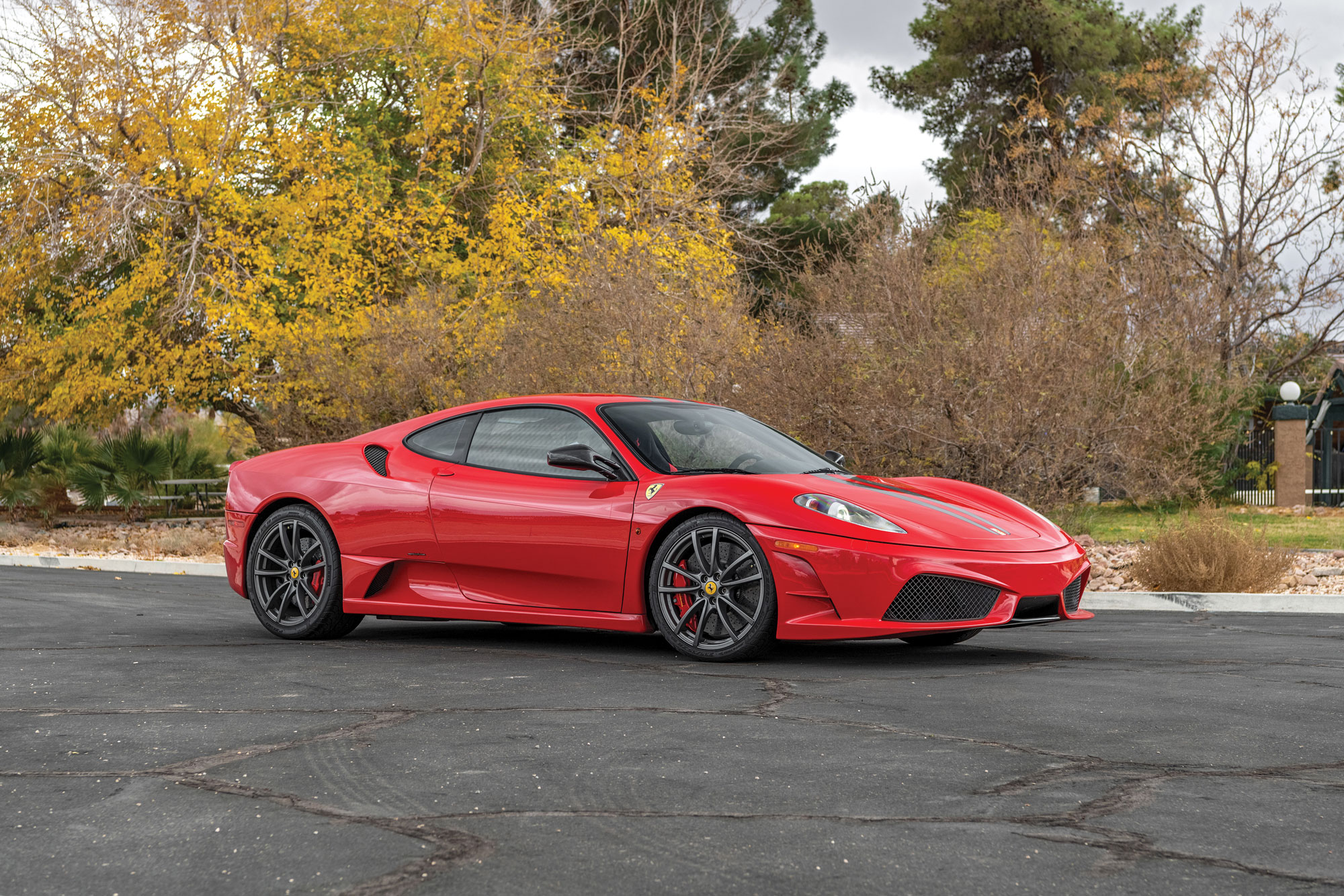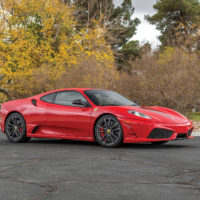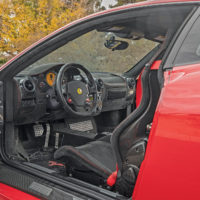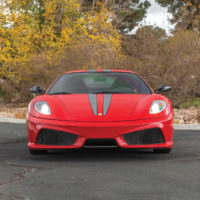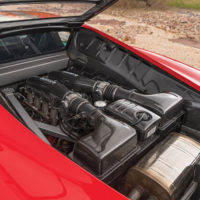SCM Analysis
Detailing
| Vehicle: | 2009 Ferrari 430 Scuderia |
| Years Produced: | 2007–09 |
| Number Produced: | 1,900 (estimated) |
| SCM Valuation: | $195,500 |
| Tune Up Cost: | $2,000 |
| Chassis Number Location: | Driver‘s door jamb |
| Engine Number Location: | Stamped on the top |
| Club Info: | Ferrari Club of America |
| Website: | http://www.ferrariclubofamerica.org |
| Alternatives: | 2003 Ferrari (360) Challenge Stradale, 2006–12 Porsche GT3 RS, 2009–13 Chevrolet Corvette ZR1 |
| Investment Grade: | C |
This car, Lot 172, sold for $285,500, including buyer’s premium, at RM Sotheby’s Phoenix, AZ, auction, on January 27, 2022.
Frank Stephenson found the Ferrari 360’s exterior to be “a bit soft, as if they left it in the oven for too long.” Stephenson is the designer responsible for the modern BMW Group-built Mini Cooper, the modern Fiat 500 and the McLaren P1, among others. He was also the first in-house design director for Ferrari. Luca di Montezemolo, then Ferrari’s CEO, brought Stephenson in to oversee Pininfarina’s work for Ferrari, which he felt was becoming a bit too conservative.
Montezemolo was looking to give next-generation Ferraris a little more edge, and it was Stephenson’s job to pen Ferrari’s 360 Modena replacement. Stephenson’s YouTube channel hosts an entertaining video in which the designer describes how Phil Hill’s 1961 Formula One championship-winning “sharknose” 156 F1 race car was his inspiration in designing the F430. It then goes on to show Stephenson sketching the car while narrating its high points.
Stephenson describes the F430’s design as having romance and finesse, traits he finds missing from today’s aggressively styled offerings. He calls the new cars “monster-looking,” which, taken literally, might be what the designers intended.
Pretty, potent, reliable
If the styling of the F430 is finessed, the performance isn’t. In stock form, the F430’s 4.3-liter V8 delivers a brutal 490 hp, an astonishing 90 more than the model it replaced. F430s could be ordered with either a 6-speed manual or a paddle-shifted, 6-speed, F1-style transmission. Fitted with the F1 transmission, the F430 hit 62 mph from a standstill in a scant 4.0 seconds. Ferrari claims a top speed of over 196 mph. Those numbers rival Ferrari’s legendary F40 supercar.
The F430 engine’s impressive output was accomplished with four valves per cylinder, one less than the 360. The drivetrain is a wizard’s brew of high-tech marvels whose duties are in the realm of NASA-level engineers. The good news is the rubber timing belts that had been the bane of Ferrari ownership for the previous 30 years are gone, replaced by durable metal timing chains. No longer would owners have to make regular trips to sercice for expensive belt changes. The switch was so profound that Ferrari would later offer seven years of free maintenance, with little more than regular oil changes being needed.
The bad news was that independent shops could no longer fix your car so easily. Serious technical training, sophisticated computer diagnosis and uber-expensive parts are needed if a driveline issue erupts. Modern Ferraris require fewer trips to the shop, but if a problem develops, a Ferrari dealer visit may be your only alternative.
That speciale sizzle
Early Ferrari road cars were often domesticated versions of Ferrari race cars. Modern Ferrari speciales turn the concept upside down. The modern speciales start as standard production models that are then upgraded using technology from Ferrari racing.
Following the tradition of the 348 Serie Speciale, 355 Serie Fiorano, and the (360) Challenge Stradale, Ferrari produced a final-edition hot rod to close out F430 production. The 430 Scuderia (or “430 Scud,” as it is sometimes called) is a blend of aggressive styling updates and performance enhancements derived from the Ferrari Challenge racing series. The result was one of the most exciting cars of the era.
Any thought that a Scuderia is a dressed-up version of an F430 should be left at the door. The technology built exclusively into the Scuderia version of the 430 goes beyond my ability to decipher. F1-style ignition coils and a differential that combines the 599’s F1-Trac traction control and electronically modulated torque output is understandable. A CPU that monitors spark-plug ionizing current is beyond me.
What’s not hard to grasp is the F1 SuperFast 2 transmission. Another Scuderia exclusive, the SuperFast 2 shifts as fast as the CPU can process the movement of the paddle. Shifting is so fast that a dampener mode is provided for softer shifting.
The 430 Scuderia is about a half-inch lower than the F430 and it has larger wheels and track-ready carbon-ceramic brakes. All the extras added to the 430 Scuderia’s 510 hp make the Scud two seconds faster around Fiorano than an F430 and virtually equal to an Enzo on the same track.
A limited-edition open-top version of the 430 Scuderia was also produced. The Scuderia Spider 16M was named for Ferrari’s 16th Formula One Constructor’s World Championship. Just 499 16Ms were built, with production allocated to Ferrari’s best clients. The 16M also featured special livery and badging.
The best, for less
Our subject car was previously auctioned by RM in 2007. That time it sold for $231,000 against a $250,000–$300,000 estimate. RM recycled the $250,000–$300,000 estimate for this sale with a much stronger final result.
A 4,500-mile Ferrari speciale is the trophy car most collectors lust for. This one had a black eye in the form of a bad CARFAX, indicating a prior rear-end collision. A third-party specialist had been hired to inspect the car and remarked that it had found no evidence of damage. As the sale price fell midway of RM Sotheby’s market-correct estimate, bidders apparently accepted the inspector’s report.
This result wasn’t a surprise, but elsewhere the F430 market has been totally baffling. Three times this year, a low-miles, manual-transmission F430 has broken $300,000 on Bring a Trailer. Manual F430s are scarce but not rare. A Scuderia’s MSRP when new was nearly double an F430’s. Given that Scuds are faster and cooler than an F430, buying one for less money has to be a good deal. The buyer and seller both did well here. ♦
(Introductory description courtesy of RM Sotheby’s.)
